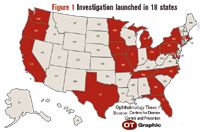Article
CDC examines apparent Acanthamoeba keratitis outbreak
Ophthalmologists and epidemiologists around the country are growing concerned about an apparent increase in the number of Acanthamoeba keratitis cases they are seeing.

In the Chicago area alone, cornea specialists have seen 67 cases since June 1, 2003. Previously, they saw two to three a year, said Elmer Y. Tu, MD, an associate professor of clinical ophthalmology at the University of Illinois at Chicago (UIC) and director of the cornea and external disease service at the UIC Eye and Ear Infirmary.
The Chicago-area cases, coupled with other reported increases at Wills Eye at Jefferson, Philadelphia, and others around the country, have led the Centers for Disease Control and Prevention (CDC) to launch a multi-state "call for cases" to identify trends and develop hypotheses about potential risk factors and prevention measures.
Acanthamoeba keratitis is a severe, often painful infection of the cornea that causes corneal scarring and frequently requires a corneal transplant. The Acanthamoeba organism lives in contaminated water and frequently is associated with contact lens use.
"One of the issues with Acanthamoeba keratitis is that, at various stages, it can look like other things," said Dr. Tu.
Its diagnosis is often delayed because it first must be suspected and then confirmed by confocal microscopy or culture on amoe ba-specific agars, or diagnosed through pathologic examination of involved tissue. It often is mistaken for herpes. Acanthamoeba keratitis, however, typically does not resolve spontaneously and continues to worsen until a patient receives the appropriate treatment.
Patients typically are seen by three to five ophthalmologists before they are referred to a center with the capability to diagnose the keratitis, Dr. Tu said. As a result, the disease often is undiagnosed for several weeks or months, he added.
Compounding the problem is that no FDA-approved treatments exist for Acanthamoeba keratitis, he said. Compounding pharmacies can formulate effective treatments, however.
After consulting with UIC on the possible increase in Illinois, the CDC informally contacted several ophthalmology centers around the country, and many did not report an increase, according to Dr. Verani. Jan. 19, the decision was made to contact a sample of the centers formally and request the numbers of cases from 1999 to 2006.
"From information received on March 2, 2007, it was apparent that the number of culture-confirmed Acanthamoeba keratitis cases increased starting in 2004," she said.
Acanthamoeba keratitis is so "exceedingly rare" that many ophthalmologists might not be familiar with it, said CDC spokesman Tom Skinner. Nationally, ophthalmologists see about one or two cases per million each year, he said. About 85% of those cases are among contact lens wearers, he added.
"There's a lot of work (in the investigation) that goes into trying to inform ophthalmologists about what's going on, what to look for, how to process information, and how to process specimens," Skinner said. Ophthalmologists may be contacted directly by CDC or by local or state health departments.
Chicago's experience
In Chicago, Dr. Tu's practice installed a confocal microscope in May 2000, and the practice saw a "smattering" of cases because it was the only center in the area with such a tool, which is used primarily to identify Acanthamoeba. By mid-2003, he and his colleagues suspected an increase.
Newsletter
Don’t miss out—get Ophthalmology Times updates on the latest clinical advancements and expert interviews, straight to your inbox.




